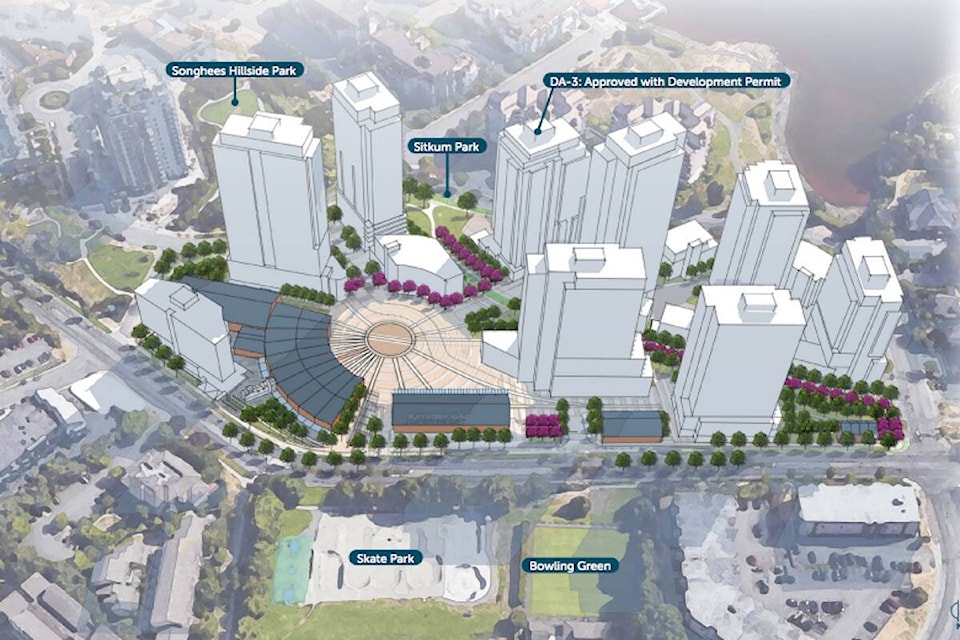More than a decade from now, Patty Mariash predicts she’ll look fondly at her involvement in creating a beautiful place where people can meet, play and enjoy themselves in what was polluted, underused lands in Vic West.
“There’s something really rewarding about that,” the Focus Equities co-owner said.
That was in response to a question about how it will feel to see her company’s transformation of the area bordering Catherine, Esquimalt, Sitkum and Kimta roads come to fruition.
Victoria council on Thursday (Jan. 25) approved the Roundhouse at Bayview Place, leaving only some procedural steps left for the long-proposed project.
The redevelopment will overhaul the largely unused property with almost 1,900 homes across towers ranging from 10 to 32 storeys.
That will be paired with elements aiming to make the property a standalone community, such as 70,000 square feet of new retail and commercial space, new public plazas, a child-care centre and revitalized heritage buildings.
With its close proximity to downtown, the project has been billed as an ideal site for density as it will allow people to easily walk, bike or bus to and from the city’s core. It will also include new transit-supporting elements, a multi-use trail and greenway running along the E&N Railway that bisects the property, new crosswalks across Esquimalt Road and new linkages to surrounding parks.
The redevelopment also promises to upgrade those parks, plant hundreds of new trees and dedicate 40 per cent of the site to public space.
Thursday’s decision was the culmination of a three-night public hearing on the current proposal as plans have been considered for over 15 years. With talks of developing the site going back even further, Mariash said densifying the land is long overdue. She complimented council for recognizing the housing situation in front of them while noting she’s heard from local students about their struggles to live in the capital.
“To have a healthy community, you have to be able to provide homes for people and you have to be able to retain your young people with jobs and with homes so they can have families and grow and prosper and stay in Victoria,” Mariash said.
The condo-driven plans also include rental buildings, the flexibility for some hotel space and a non-profit-operated building with 215 below-market homes.
Mayor Marianne Alto on Friday said the approval shows council is willing to open every door possible when it comes to creating housing across the affordability spectrum. She called it a transformational move for the quickly growing city, while noting Victoria still values its charm, mid-sized feel and Indigenous and colonial history.
“But it’s a city, and we’re embracing that,” the mayor said outside City Hall.
Representatives for the Roundhouse emphasized the project was centred around revitalizing the industrial rail buildings that hold National Historic Site status – while animating the space around them so the heritage value can be celebrated.
A plaza around the historic buildings will aim to be the community “heart” as it hosts shopping, dining, performances and events. On Thursday, a Roundhouse planner said they hope to bring back rail cars into the space that can be used as food trucks or art studios. Storytelling about the site – used by the Lekwungen people for thousands of years – and its history will be included throughout the public spaces, the planner said.
Still, heritage aspects being overwhelmed was a frequent concern voiced by the plan’s opponents during the public hearing, with councillors who voted for and against the project also echoing that view to different degrees.
Mariash said they’re putting substantial investments toward the land’s required remediation and have designed the site – across multiple iterations of the plans – so that it brings people to the restored rail structures.
“The only thing that animates the site is people, and the only way to get people to the site is to build homes,” she said.
The public hearing’s final day also saw many resident concerns addressed by city staff and the project’s team. Among the highlights were staff saying underground infrastructure would be upgraded at the developer’s expense, a third-party traffic impact assessment was accepted by the city and Victoria’s fire chief saying the department has no concerns about responding to the high buildings.
Councillors each walked the political tightrope by touting the project’s many benefits while recognizing its imperfections. Their concerns included too much density, the heritage buildings and whether Victoria should have towers in the first place, but they cheered about the diverse housing types, how the project will benefit local businesses and tourism and how it will create of a complete community.
Councillors Marg Gardiner and Stephen Hammond voted against the proposal.
It will likely take around 15 years for the project to be significantly built out, while specific timelines will depend on construction market conditions.
The project’s plans will be adopted upon the city being satisfied that potential impacts to one of the harbour’s floatplane flight paths have been addressed.



